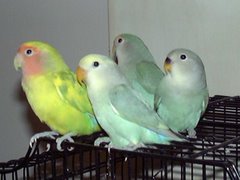How to Care Lovebirds?
Do you know all the wild birds will mask signs of sickness as a way of existing? So, once your lovebird exhibits signs of ill health such as sitting at the cage floor, mucus from nostrils and soiled vent. You ought to take care your lovebirds at this situation.
You should consult an avian vet immediately. The healthy lovebirds should have smooth feathers, clear bright eyes, normal stools, clear bright eyes, a healthy appetite, eating throughout the day, normal level of activity and a clean vent.

Wings Trimming
Next step in caring lovebirds involve trimming of the wings. If you are an experienced bird handler, you may use wing-clipping scissors that are designed specifically for this application. Or trimming process should be performed by an avian vet to prevent any problems.
Nail trimming
Most of the lovebird owners may ask how to care my lovebird's nail. In wild, the lovebirds will trim their nails and beak with rough branches of trees. In the captive conditions, you should provide cuttle bones and bird perches of a variety of textures in order to keep its beak and toe nails in good shape. Too long nails may be trimmed with the help of bird clippers. Be careful while trimming the nails as you severe up to the vein.
Cage care for lovebirds
Weekly cleaning of birdcages should be advocated regularly. Washing the birdcage with birdcage cleaners also being advised. A mixture should be prepared by mixing 1 gallon of water and ¾ cup bleach to disinfect the cage. Replace the good old cage parts made up of wood or wooden toys and perches as they may get dirt with droppings.
Caring lovebirds involves allowing them to let out of their cage daily as they have a exhaust their excess energy by flying. The lovebirds should be allowed to fly after closing all windows and also switch off the ceiling fans. Even you can use a bird leash to have more control over the birds while it is flying.
You should consult an avian vet immediately. The healthy lovebirds should have smooth feathers, clear bright eyes, normal stools, clear bright eyes, a healthy appetite, eating throughout the day, normal level of activity and a clean vent.

Wings Trimming
Next step in caring lovebirds involve trimming of the wings. If you are an experienced bird handler, you may use wing-clipping scissors that are designed specifically for this application. Or trimming process should be performed by an avian vet to prevent any problems.
Nail trimming
Most of the lovebird owners may ask how to care my lovebird's nail. In wild, the lovebirds will trim their nails and beak with rough branches of trees. In the captive conditions, you should provide cuttle bones and bird perches of a variety of textures in order to keep its beak and toe nails in good shape. Too long nails may be trimmed with the help of bird clippers. Be careful while trimming the nails as you severe up to the vein.
Cage care for lovebirds
Weekly cleaning of birdcages should be advocated regularly. Washing the birdcage with birdcage cleaners also being advised. A mixture should be prepared by mixing 1 gallon of water and ¾ cup bleach to disinfect the cage. Replace the good old cage parts made up of wood or wooden toys and perches as they may get dirt with droppings.
Caring lovebirds involves allowing them to let out of their cage daily as they have a exhaust their excess energy by flying. The lovebirds should be allowed to fly after closing all windows and also switch off the ceiling fans. Even you can use a bird leash to have more control over the birds while it is flying.







 Free Ads For Bloggers
Free Ads For Bloggers


No comments:
Post a Comment